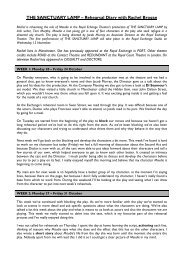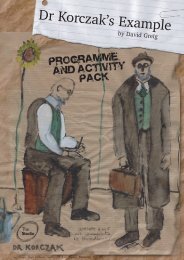“General” Front & Back - the Royal Exchange Theatre
“General” Front & Back - the Royal Exchange Theatre
“General” Front & Back - the Royal Exchange Theatre
You also want an ePaper? Increase the reach of your titles
YUMPU automatically turns print PDFs into web optimized ePapers that Google loves.
Henrik Ibsen<br />
Peer & Åase from <strong>the</strong><br />
1962 Old Vic production<br />
Avoid<br />
anachronisms<br />
Michael believes that<br />
anachronisms are<br />
destructive and has<br />
“made it a rule never<br />
to use any word that<br />
would not have been<br />
current English at<br />
<strong>the</strong> time <strong>the</strong> play in<br />
question was<br />
written; apart from<br />
<strong>the</strong> intrinsic<br />
vulgarity of<br />
anachronisms, any<br />
attempt to update<br />
dialogue will date<br />
within a decade.”<br />
Being confined to<br />
“<strong>the</strong> 95% or 97% of<br />
words which are<br />
common to both<br />
1899 and 1999” is<br />
not too difficult a<br />
task for <strong>the</strong><br />
Michael<br />
Meyer<br />
outlines <strong>the</strong><br />
key points for<br />
a good<br />
translation:<br />
Know <strong>the</strong><br />
language<br />
An obvious point,<br />
but <strong>the</strong>re is a fashion<br />
for <strong>the</strong>atre companies<br />
to commission<br />
distinguished playwrights<br />
to create versions of foreign<br />
plays, working from a literal<br />
translation. As Michael Meyer points<br />
out, <strong>the</strong>re can be flaws to this<br />
approach:<br />
“There are quite a lot of people who think you<br />
can get someone bilingual to do a literal<br />
translation and <strong>the</strong>n kick it around, but that’s no<br />
good. I know that because <strong>the</strong> first Ibsen I ever<br />
translated, over forty years ago in 1955, was Little Eyolf<br />
for BBC radio. I knew Swedish but I didn’t know<br />
Norwegian and I got a bilingual lady to be my intermediary.<br />
Although she was completely bilingual she couldn’t read a play.<br />
Some years later, by <strong>the</strong> time I had learned Norwegian, I had to<br />
revise <strong>the</strong> translation for publication and I had to alter almost every<br />
line because she had missed <strong>the</strong> point entirely! With a literal translation of<br />
someone like Ibsen, where <strong>the</strong>re are very subtle nuances, all you get is an<br />
approximation of <strong>the</strong> text.”<br />
Be faithful to <strong>the</strong> play<br />
translator since <strong>the</strong><br />
English language has<br />
changed very little in <strong>the</strong><br />
course of <strong>the</strong> century. In<br />
contrast, Michael<br />
believes, in <strong>the</strong> one<br />
hundred years since<br />
Ibsen was writing, “<strong>the</strong><br />
Norwegian language has<br />
changed as much as<br />
English has in two<br />
hundred years.” This<br />
means that in <strong>the</strong> original<br />
Norwegian, <strong>the</strong> language<br />
of <strong>the</strong> plays can sound<br />
extremely dated.<br />
Norwegian actors like<br />
Espen Skjønberg (who<br />
plays <strong>the</strong> Button Moulder)<br />
approaching Ibsen in<br />
English often feel relieved<br />
“to be acting Ibsen in a<br />
language which doesn’t feel<br />
old-fashioned!”<br />
Translation Tips<br />
The translation used in <strong>the</strong> <strong>Royal</strong> <strong>Exchange</strong> <strong>Theatre</strong><br />
production is by Michael Meyer, <strong>the</strong><br />
distinguished translator and biographer of<br />
Ibsen and Strindberg. For director<br />
Braham Murray, <strong>the</strong>re was no doubt<br />
about which translation to use:<br />
“Michael Meyer did this translation<br />
back in 1962 for Michael Elliott, a<br />
former director of this<br />
Michael believes that it is an advantage for a translator not to be a famous<br />
playwright. “The most difficult thing, if <strong>the</strong> translator is a creative writer himself, is to<br />
keep himself out of it, to resist leaving his thumbprint. Gogol once observed that<br />
<strong>the</strong> ideal translation should be like a new window pane. One should not be aware<br />
that it exists.”<br />
Choose <strong>the</strong> dramatic medium with care<br />
company. He is <strong>the</strong> best<br />
translator of Ibsen. There<br />
wasn’t much competition<br />
really.”<br />
With Peer Gynt, written in a subtle, rhymed verse, translators must choose<br />
whe<strong>the</strong>r to use verse or prose. If <strong>the</strong>y are using verse, what sort of verse<br />
form is most suitable? Before approaching Peer Gynt, Michael had<br />
confronted <strong>the</strong>se same choices when tackling Ibsen’s Brand:<br />
“The first decision I made was that one obviously can’t translate it<br />
into rhymed verse because rhyme in English is death to any dialogue<br />
except farce. I tried prose and it just didn’t work. The difficulty was,<br />
and it is <strong>the</strong> same with Peer Gynt, that you move between <strong>the</strong><br />
sublime and <strong>the</strong> slightly frivolous. You have got to have a medium in<br />
which you can move from one to <strong>the</strong> o<strong>the</strong>r without seeming<br />
incongruous. I tried it in blank verse for a page or so, and that did<br />
not work ei<strong>the</strong>r. Then I remembered T.S. Eliot who is a poet and<br />
playwright I much admire. I remembered <strong>the</strong> medium he had used in<br />
The Family Reunion: a kind of free verse. He said he did not want <strong>the</strong><br />
audience to realise it was listening to verse. If <strong>the</strong>y are conscious<br />
that <strong>the</strong>y are listening to poetry <strong>the</strong>n <strong>the</strong> dialogue becomes a bit<br />
like opera - <strong>the</strong>y know it is not really happening. He used a free<br />
verse, not always easily distinguishable from prose, but in<br />
which one could be high-flown without seeming<br />
incongruous. That is what I tried to do in both Brand<br />
and Peer Gynt.”<br />
Contemporary illustration of Ibsen<br />
Q uotations are taken from Michael<br />
Meyer’s memoirs, Not Prince<br />
Hamlet (1989) and from a 1999<br />
interview with <strong>the</strong> translator.




